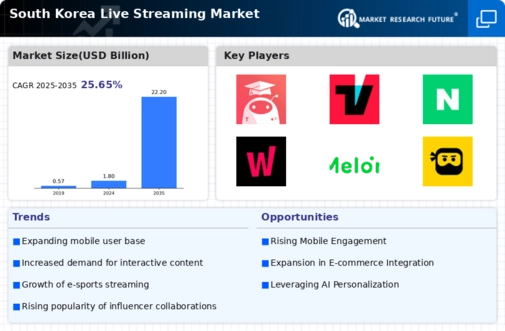Growing Popularity of E-sports
The live streaming market in South Korea is significantly influenced by the burgeoning popularity of e-sports. With a rich history in competitive gaming, South Korea has established itself as a hub for e-sports events, attracting millions of viewers both locally and internationally. In 2025, the e-sports industry is projected to generate revenues exceeding $1 billion, with a substantial portion derived from live streaming platforms. This trend is further fueled by the increasing number of professional gamers and tournaments, which are often broadcasted live, creating a vibrant community around these events. The engagement levels during live e-sports broadcasts are notably high, with viewers actively participating through chat and social media interactions. This dynamic environment not only enhances viewer retention but also encourages brands to invest in sponsorships and advertising within the live streaming market, thereby contributing to its overall growth.
Rise of User-Generated Content
The live streaming market in South Korea is significantly impacted by the rise of user-generated content (UGC). Platforms that allow users to create and share their own live streams are gaining traction, fostering a sense of community and participation. This trend is particularly appealing to younger audiences, who are increasingly seeking authentic and relatable content. In 2025, it is estimated that UGC will account for approximately 40% of all live streaming content consumed in South Korea. The democratization of content creation empowers individuals to showcase their talents, hobbies, and experiences, which resonates well with viewers. Furthermore, brands are beginning to recognize the potential of collaborating with popular streamers to reach target audiences effectively. This shift towards UGC is likely to reshape the landscape of the live streaming market, encouraging more diverse content and engagement strategies.
Shift Towards Mobile Streaming
The live streaming market in South Korea is witnessing a notable shift towards mobile streaming, driven by the increasing penetration of smartphones. As of 2025, over 95% of the population owns a smartphone, making mobile devices the primary medium for content consumption. This trend is particularly evident among younger demographics, who prefer accessing live content through their mobile devices rather than traditional platforms. The convenience of mobile streaming allows users to engage with content anytime and anywhere, which is essential in today’s fast-paced lifestyle. Additionally, mobile applications are increasingly incorporating interactive features, such as live chats and polls, enhancing user engagement. This shift is likely to continue, as mobile streaming platforms adapt to user preferences, thereby expanding their reach and solidifying their position within the live streaming market.
Technological Advancements in Streaming
The live streaming market in South Korea is experiencing a surge due to rapid technological advancements. Innovations in internet infrastructure, particularly the rollout of 5G technology, have significantly enhanced streaming quality and reduced latency. This improvement allows for seamless high-definition content delivery, which is crucial for user engagement. As of 2025, approximately 80% of South Korean households have access to high-speed internet, facilitating a robust environment for live streaming services. Furthermore, advancements in mobile technology enable users to stream content on-the-go, expanding the audience base. The integration of artificial intelligence in content recommendation systems also plays a pivotal role in personalizing user experiences, thereby driving growth in the live streaming market. These technological developments are likely to continue shaping the industry, making it more accessible and appealing to a broader demographic.
Increased Investment in Content Creation
The live streaming market in South Korea is experiencing increased investment in content creation, as companies recognize the potential for high returns. In 2025, it is projected that investments in live streaming content will exceed $500 million, driven by both established media companies and new entrants. This influx of capital is aimed at producing high-quality, original content that attracts viewers and retains their attention. Additionally, partnerships between streaming platforms and content creators are becoming more common, allowing for innovative programming that caters to niche audiences. The focus on diverse content offerings is likely to enhance viewer engagement and loyalty, which are critical for success in the competitive landscape of the live streaming market. As investments continue to grow, the quality and variety of content available to consumers are expected to improve, further propelling market expansion.
























Leave a Comment